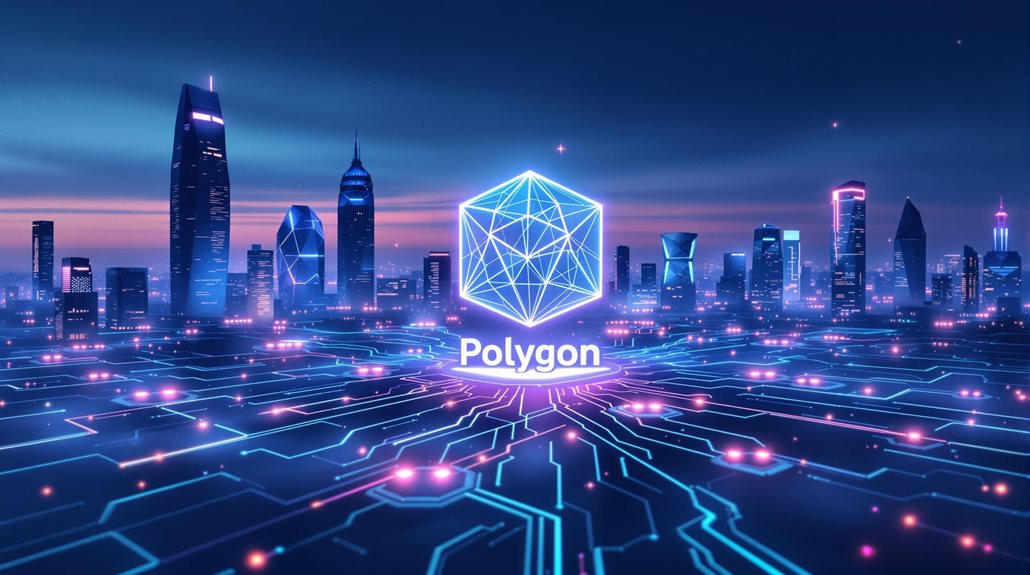Polygon (formerly Matic Network) is a popular blockchain platform that works alongside Ethereum to make transactions faster and cheaper. It's like a highway that runs parallel to Ethereum's busy road, helping to reduce traffic and fees. The platform uses its MATIC token for various purposes, including network security and transaction fees. Polygon processes up to 65,000 transactions per second and has attracted major projects in DeFi and NFTs. There's much more to discover about this innovative blockchain solution.

Polygon, formerly known as Matic Network, is a popular Layer 2 scaling solution built on top of the Ethereum blockchain. The project, which launched in 2017 and rebranded in 2021, aims to solve some of Ethereum's biggest challenges by improving transaction speeds and reducing fees while maintaining security and decentralization. Users benefit from fast settlement times with an average block time of approximately 2.1 seconds.
The platform's technical architecture relies on sidechains that process transactions independently from Ethereum's main chain. It uses a Proof-of-Stake consensus mechanism and implements something called the Plasma framework to create efficient sidechains. Through its Commit Chain system, Polygon maintains a connection to Ethereum's mainchain, ensuring security and interoperability. With its advanced technology, Polygon can process up to 65,000 transactions per second. Token holders who participate in transaction validation can earn MATIC rewards for securing the network.
At the heart of Polygon's ecosystem is its native token, MATIC. It's an ERC-20 token that serves multiple purposes within the network. Users can stake MATIC to help secure the network, participate in governance decisions, and pay for transaction fees. One unique feature is that MATIC enables users to initialize wallets for NFT transactions without paying gas fees. The token is set to undergo an upgrade to become POL in the future.
Polygon's infrastructure has attracted many prominent projects in the blockchain space. Popular decentralized finance (DeFi) platforms like Curve Finance, Aave, and SushiSwap have integrated with Polygon to offer their services with lower fees and faster transactions. NFT marketplaces, including OpenSea, also use Polygon to provide a more cost-effective way for users to mint and trade digital collectibles.
The platform provides developers with tools to build their own Ethereum-compatible networks through the Polygon SDK (Software Development Kit). This flexibility has made it easier for projects to create custom blockchain solutions while benefiting from Ethereum's security and established ecosystem.
Polygon's design combines the best aspects of standalone blockchains with Ethereum's robust security and vibrant community. By acting as a scaling solution, it helps address Ethereum's limitations while maintaining compatibility with existing tools and applications. This approach has made it particularly attractive for developers who want to build decentralized applications without worrying about high gas fees or slow transaction times.
The platform continues to serve as a bridge between different blockchain networks, making it easier for users to interact with various decentralized applications. Its focus on scalability and interoperability has positioned it as a key player in the broader blockchain ecosystem, particularly in areas like DeFi and NFTs where efficient transactions are essential.
Frequently Asked Questions
How Does Polygon's Gas Fee Compare to Other Layer 2 Solutions?
Polygon's gas fees are among the most competitive in the Layer 2 space.
It's generally cheaper than Optimism and Arbitrum, which have similar fee structures but run slightly higher costs.
Polygon's fees are comparable to zkSync, while Loopring offers lower fees specifically for DEX trading.
StarkNet matches Polygon's competitive pricing.
During typical network conditions, Polygon users pay between 0.008 to 0.05 MATIC per transaction, roughly $0.01-$0.05.
Can I Stake MATIC Tokens Directly From a Hardware Wallet?
Yes, it's possible to stake MATIC tokens directly from hardware wallets like Ledger.
Users need to connect their hardware wallet to MetaMask and then link it to the Polygon Web Wallet. The process requires installing the Ethereum app on the hardware wallet and enabling blind signing.
While staking occurs on the Ethereum network, not the Polygon network, hardware wallet staking offers enhanced security through offline private key storage.
What Happens to MATIC Tokens During Network Upgrades?
During network upgrades, MATIC tokens typically go through a conversion process.
In the recent upgrade to POL, staked MATIC tokens automatically convert at a 1:1 ratio. Tokens on the Polygon PoS chain don't need any action from holders.
However, MATIC tokens on the Ethereum network require manual conversion. There's no set deadline for the upgrade, and holders can use an upgrade portal when they're ready to convert.
Does Polygon Have Plans to Implement Zero-Knowledge Rollups?
Yes, Polygon is heavily invested in zero-knowledge (ZK) rollup technology, having committed over $1 billion to its development.
They've already launched several ZK solutions, including Polygon Zero, Hermez, Miden, and Nightfall.
Their most significant achievement is Polygon zkEVM, which went live on Ethereum's mainnet in March 2023.
They're also planning to shift their main PoS chain to a zkEVM Validium, showing their strong commitment to ZK technology.
How Does Polygon Handle Network Congestion During High-Traffic Periods?
Polygon manages high traffic through its pending transaction pool, where transactions wait their turn to be processed.
It's like a virtual waiting line. The network's block producers pick transactions that have higher gas fees first. Users can speed things up by increasing their gas fees to jump ahead in line.
Polygon's Gas Price Tracker helps users see current network fees, while its Commit Chain technology keeps transactions moving quickly even during busy times.





